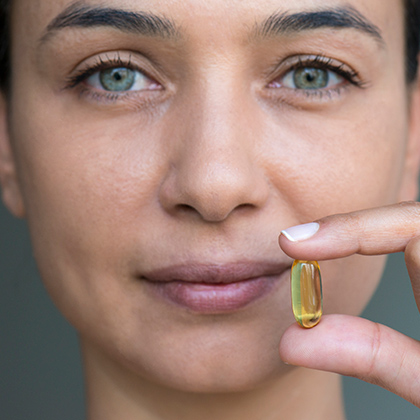
We are constantly informed by medical professionals and public health campaigns of how dangerous smoking can be for our health. On top of the widely-known related conditions such as cancer and heart disease, smoking also has an impact on our eye health. Since our hub focuses on managing eye health, we’ve broken down the science behind how smoking can impact your eyes, as well as offering advice to help you quit smoking once and for all.
How does smoking affect eye health?
The impact of smoking on eye health is still widely unknown. In 2004, the UK Government published figures which found that 18,000 people suffered from a loss of vision as a result of smoking-induced macular degeneration.i, ii
When you take a puff of a cigarette smoke, chemicals are absorbed by the lungs and transferred into the bloodstream. Carbon monoxide in cigarette smoke binds to the haemoglobin in red blood cells, preventing the affected cells from carrying a full supply of oxygen to the rest of the body.iii
Can nicotine affect your eyes?
Cigarette nicotine suppresses the body’s immune responses, making it harder to defend against illness and repair tissues.iv
 Studies also suggest that nicotine – when tested separately from the other chemicals in tobacco smoke – may be linked to the development of age-related macular degeneration (AMD) because of the way it affects blood vessels in a highly sensitive part of the eye call the macula, not just in smokers but non-smokers too (by way of passive smoking)v, vi. These studies were, however, carried out in mice and rats. But while the link hasn’t yet been firmly established in humans, it’s suspected that nicotine may have a similar effect.
Studies also suggest that nicotine – when tested separately from the other chemicals in tobacco smoke – may be linked to the development of age-related macular degeneration (AMD) because of the way it affects blood vessels in a highly sensitive part of the eye call the macula, not just in smokers but non-smokers too (by way of passive smoking)v, vi. These studies were, however, carried out in mice and rats. But while the link hasn’t yet been firmly established in humans, it’s suspected that nicotine may have a similar effect.
All of these factors make the eyes more susceptible to a number of conditions, such as age-related macular degeneration (AMD), cataracts, glaucoma and dry eye syndrome.vii
Age-related macular degeneration (AMD)
Age-related macular degeneration involves the erosion of the macula – the central part of the retina that enables you to see intricate details such as faces, words on a page and subtleties in colours. When the macula begins to decline, you can experience distortions, blurriness, blind spots in your central vision, and in some cases loss of vision.viii
Smoking increases the risk of vision loss from AMD by interfering with the blood flow to the retina.ix On top of this, nicotine also increases the effects of oxidative stress in the macula.x According to a 2005 study, smokers are 3 times more likely to experience AMD and may develop this condition 10 years earlier than their non-smoking counterparts.xi, xii Although there’s no simple cure for AMD, there are ways to delay the advancement of the disease. Your doctor could prescribe anti-angiogenic medication to prevent the triggering of macular deterioration.xiii Laser therapy is another option, or you could try more natural methods of supplementation outlined in our article.
Cataracts
Often a product of old age, cataracts is the most common cause of vision loss.xvi Cataracts are most easily identified by a clouded lens, causing faded colours, increased sensitivity to glare, blurriness and overall poor vision.xv
An increasing amount of research has highlighted the relationship between smoking and cataracts.xvi According to one study, smokers are three times more likely to develop nuclear cataracts – the most common form of the condition.xvii It’s believed that smoking alters cells in the lens of the eye through oxidation, making them more prone to developing cataracts.xviii Data also suggests cigarette smoke can lead to a build-up of metal residue, in particular cadmium, in the lens —another contributing factor to the condition.xix
As worrying as the condition may sound, there are a number of ways to manage cataracts which you can find in our article.
Can smoking cause glaucoma?
Studies in the past few years have found a link between smoking and the development of glaucoma. Glaucoma is indicted by the progressive deterioration of the optic nerve, the part of the eye that sends visual information to your brain, which can result in a complete or partial loss of vision.xx The condition itself is more common than you might think, with 60 million affected people worldwide.xxi Since symptoms often develop over a period of time, a comprehensive eye exam is the only way to detect this disease, meaning it can lay undetected for many years.
Glaucoma is known to be caused by compromised blood flow to the optic nerve, cigarette smoke may contribute to this by increasing the formation of plaque in blood vessels.xxii In addition, smoking is known to trigger high oxidative stress in the body, which could be another contributing factor of glaucoma.xxiii One study found a direct association between smokers and the incidence of glaucoma.xxiv, xxv It’s worth noting that in contrast to some other risk factors such as age and family history, smoking is manageable. By changing this habit, you could reduce the likelihood of developing glaucoma.
Although there’s no simple cure for glaucoma, changing your diet alongside quitting smoking is a less invasive option.
Does smoking cause red eyese?
Dry eyes are often characterised by redness as well as burning, itchiness, tearing, discharge and light sensitivity.xxvi Smoking has been widely found to increase these symptoms of irritation. Cigarettes contain over 7,000 chemicals – many of which can aggravate eyes. Studies tell us the chemicals in smoke can rupture the protective layer of tears, sometimes causing irreversible damage.xxvii Without this shield to keep eyes lubricated, they can become dry and irritated.
Of course, the best dry eye relief is stopping smoking for good. But we know that doesn’t always happen overnight. In the meantime, use preservative-free artificial tears and gels to soothe your eyes. You may also consider Sea Buckthorn Berry Oil (rich in nourishing fatty-acids), or other forms of natural supplementation, to help keep your eyes lubricated.
How to quit smoking
Prioritising your eye health and maintaining good vision is yet another reason to quit smoking. Studies suggest those who ditch the cigarettes will have a 6.7% reduced risk of developing AMD after just one year, and after five years, the risk drops to 1.7%.xviii To help, we’ve compiled some steps to make quitting a little easier.
Get planning
Set a date, stick to it and make a pledge to yourself. Think ahead to times when passing on a cigarette might be challenging – at a party, for instance. Remember, a craving can only last 5 minutes. So before you give in to that short-lived nicotine high, make a list of quick-fire strategies to distract you: call a friend, make a cup of tea, get some fresh air and go for a walk around the block.
Think of the benefits
There are so many ways in which your health will improve when you give up smoking. Better circulation, better lung function, a healthier heart and a lower risk of lung cancer are just some. Plus life will be a lot more enjoyable because you’ll feel less stressed, your skin will look younger, your breath will smell fresher, your teeth will look whiter, your sense of smell and taste will improve and you’ll have more energy. On top of all that you’ll also be protecting those around you too, as they’ll no longer be breathing in your secondhand smoke.
Also remind yourself why you’re trying to give up. Make a list of all your reasons for quitting, and read it back to yourself whenever you’re tempted to give in.
Keep your mind active
Cravings can be a challenge, but if you don’t think about them all the time they may be easier to overcome. Try to think of something else or do something to take your mind off how you’re feeling.
It’s a good idea to distract your hands too. Try starting a new creative hobby, or use a fidget toy to keep your hands busy.
Treat yourself
Depending on how many cigarettes you smoke, you could save quite a bit of money by quitting. Working out how much you’ll save, and what you could treat yourself to with the extra cash you’ll have in your pocket could be an extra incentive to stick at it.
Try nicotine replacements
Nicotine replacement therapy could double your chance of quitting smoking for good. Alongside tablets, patches, gum and nasal spray, you could even opt for an e-cigarette to wean yourself off. When you’re out, try placing your beverage in the hand you smoke with, and drink it through a straw. This will keep your hands and mouth busy.
Stay active
Taking regular exercise may help too, since it can help keep your weight down, boost your mood and improve your chances of having a good night’s sleep – all of which could help you resist cravings. Aim to do at least 150 minutes of moderate exercise each week.
Take regular breaks
If you find yourself thinking about having a cigarette when you’re under stress, try to remember that smoking increases stress and anxiety rather than reducing them. So instead of lighting up, try taking a break to relax and feel calmer – walk away or get outside into the fresh air, for instance. You may find this helps you cope with added pressure without having to smoke a cigarette.
Get support
Know a friend or family member who also wants to quit? Well, now’s the time to join forces to keep the anti-smoking sentiment high. For additional support and advice, you can also call the NHS Smokefree Helpline.
Want to discover even more ways to keep your eyes healthy? Feel free to browse the rest of our Vision Health Hub.
References:
-
Kelly, S.P., Thornton, J., Lyratzopoulos, G., et al. (2004). Smoking and blindness. Strong evidence for the link, but public awareness lags. Br Med J. 328, 357–358.
-
Stone, D (2016). Tobacco smoking and blindness - The ignored epidemic. Saudi Journal of Ophthalmology, 30(3), 149.
-
NHS.uk. (2018). Smokefree - Effects of smoking on the body. Available online: https://www.nhs.uk/smokefree/why-quit/smoking-health-problems [Accessed 21 Sep. 2018.]
-
Sopori, M. (2002). Effects of cigarette smoke on the immune system. Nat Rev Immunol. 2(5): 372-7.
-
Suner, I.J. (2006). The Biology of Smoking and AMD. Review of Ophthalmology. Available online: https://www.reviewofophthalmology.com/article/the-biology-of-smoking-and-amd
-
Pons, M. (2011). Nicotine Increases the VEGF/PEDF Ratio in Retinal Pigment Epithelium: A Possible Mechanism for CNV in Passive Smokers with AMD. Invest Opthalmol Vis Sci. 52 (6), 3842-53. Available online: https://iovs.arvojournals.org/article.aspx?articleid=216614
-
Nei.nih.gov. (2018). Healthy Eyes Facts - National Eye Institute. Available online: https://nei.nih.gov/health/healthyeyes [Accessed 21 Sep. 2018.]
-
Roth, F., Bindewald, A., Holz, F. (2004). Keypathophysiologic pathways in age-related macular disease. Graefe's Archive for Clinical and Experimental Ophthalmolog, 242(8), 710-716.
-
Lee, J. and Cooke, J. (2012). Nicotine and pathological angiogenesis. Life Sciences, 91(21-22), 1058-1064.
-
Thornton, J. and Edwards, R., Mitchell, P., Harrison, R., Buchan, I., Kelly, S. (2005). Smoking and age-related macular degeneration: a review of association. Eye, 19(9), 935-944.
-
Thornton,, et al. Smoking and age-related macular degeneration, 935-944.
-
WebMD. (2018). Age-Related Macular Degeneration Treatment. Available online: https://www.webmd.com/eye-health/macular-degeneration/age-related-macular-degeneration-treatment#1
-
World Health Organization. (2018). Causes of blindness and visual impairment. Available online: http://www.who.int/blindness/causes/en [Accessed 21 Sep. 2018]
-
National Eye Institute. (2018). Cataracts. Available online: https://nei.nih.gov/health/cataract/cataract_facts
-
Kennedy, R. and Spafford, M., Parkinson, C. and Fong, G. (2011). Knowledge about the relationship between smoking and blindness in Canada, the United States, the United Kingdom, and Australia: results from the International Tobacco Control Four-Country Project. Optometry. Journal of the American Optometric Association, 82(5), 310-317.
-
Kelly, S. Thornton, J., Edwards, R., Sahu, A. and Harrison, R. (2005). Smoking and cataract: Review of causal association. Journal of Cataract & Refractive Surgery, 31(12), 2395-2404.
-
Kennedy, , et al. Knowledge about the relationship between smoking, 310-317.
-
Raju, P. George, R., Ve Ramesh, S., Arvind, H., Baskaran, M. and Vijaya, L. (2006). Influence of tobacco use on cataract development. British Journal of Ophthalmology, 90(11), 1374-1377.
-
National Eye Institute. (2018). Glaucoma. Available online: https://nei.nih.gov/health/glaucoma/glaucoma_facts
-
Firago, V. (2016). Determination of blood flow velocity in vessels of the bulbar conjunctiva. Prezglad Elektrotechniczny, 1(8), 107-110.
-
Chavez, J.,Cano, C., Souki, A., Bermudez, V., Medina, M., Ciszek, A., Amell, A., Vargas, M., Reyna, N., Toledo, A., Cano, C. ,Suarez, G. ,Contreras, F. ,Israili, Z. ,Hermadez-Hernandez, R. and Valasco, M. (2007). Effect of Cigarette Smoking on the Oxidant/Antioxidant Balance in Healthy Subjects. American Journal of Therapeutics, 14(2), 189-193.
-
Pérez-de-Arcelus, M.,Toledo, E., Martínez-González, M., Martín-Calvo, N., Fernández-Montero, A. and Moreno-Montañés, J. (2017). Smoking and incidence of glaucoma. Medicine, 96(1), 5761.
-
Pérez-de-Arcelus,, et al. (2017) Smoking and incidence of glaucoma, 5761.
-
National Eye Institute. (2018). Glaucoma. Available online: https://nei.nih.gov/health/glaucoma/glaucoma_facts
-
Shah, S. and Jani, H. (2015) Prevalence and associated factors of dry eye: Our experience in patients above 40 years of age at a Tertiary Care Center. Oman Journal of Ophthalmology, 8(3), 151.
-
Xu L.,Zhang, W., Zhu, X.Y., Suo, T., Fan, X.Q. and Fu, Y. (2016) Smoking and the risk of dry eye: a Meta-analysis. International Journal of Ophthalmology, 9(10), 1480–1486.
-
The National. (2018). Another clear-eyed reason to quit smoking: your vision. Available online: https://www.thenational.ae/another-clear-eyed-reason-to-quit-smoking-your-vision-1.395869 [Accessed 22 Sep. 2018]
-
NHS.uk. (2018). 10 self-help tips to stop smoking. Available online: https://www.nhs.uk/live-well/quit-smoking/10-self-help-tips-to-stop-smoking [Accessed 23 Sep. 2018]
Related Posts?
Disclaimer: The information presented by Nature's Best is for informational purposes only. It is based on scientific studies (human, animal, or in vitro), clinical experience, or traditional usage as cited in each article. The results reported may not necessarily occur in all individuals. Self-treatment is not recommended for life-threatening conditions that require medical treatment under a doctor's care. For many of the conditions discussed, treatment with prescription or over the counter medication is also available. Consult your doctor, practitioner, and/or pharmacist for any health problem and before using any supplements or before making any changes in prescribed medications.

Christine
Christine Morgan has been a freelance health and wellbeing journalist for almost 20 years, having written for numerous publications including the Daily Mirror, S Magazine, Top Sante, Healthy, Woman & Home, Zest, Allergy, Healthy Times and Pregnancy & Birth; she has also edited several titles such as Women’ Health, Shine’s Real Health & Beauty and All About Health.
View More



